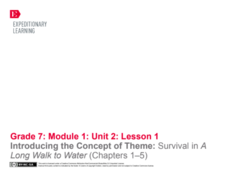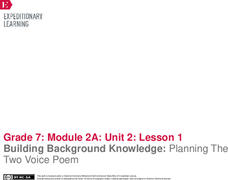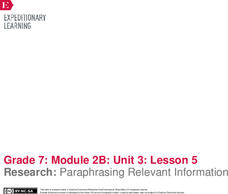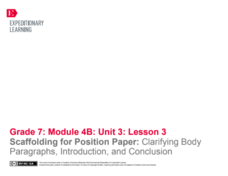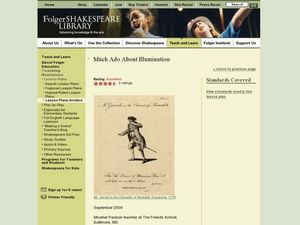Teacher's Corner
Dr. Seuss Book Report - Character
Bring the imaginative spark in every Dr. Seuss book to your reading lesson with a book report worksheet. After they read the story, learners write a short summary of the tale and include an illustration of their favorite character.
Teacher's Corner
Dr. Seuss Story Map
Guide young readers through their first book report with a story map designed for a Dr. Seuss book. After your class finishes their story of choice, they list the title, characters, conflict, and other elements of literature on the book...
Frank Macias Elementary School
Preparing for Guided Reading
Take your guided reading lesson plans to the next level with a collection of printables, templates, and reference tools equipped to support the reading needs of your readers. Included is a detailed information page, grouping sheet,...
Bierbaum Elementary School
Practicing Patience
As teachers, we have a lot of patience. Our scholars, on the other hand, may need some support. Give your pupils the emotional intelligence instruction they desire with a lesson plan designed to teach patience through grand conversation,...
Roald Dahl
Matilda - The Ghost
How do you think the parrot in "The Ghost" chapter of Matilda feels in the chimney? Put a class member in the hot seat and have the class ask questions relating to how they might have felt if they were the parrot in the chimney. Then,...
Prestwick House
"Because I could not stop for Death" -- Visualizing Meaning and Tone
Emily Dickinson's "Because I could not stop for Death" provides high schoolers with an opportunity to practice their critical thinking skills. They examine the images, diction, rhythm, and rhyme scheme the poet uses and consider how...
Prestwick House
Teaching Shakespeare: Sonnet 73
It's that time of year to consider how Shakespeare selects his images and structures his Sonnet 73 to develop the meaning of the poem. Class members examine the rhyme scheme, the indented lines, the conceit, and the images used in each...
Curated OER
Find Someone Who
Learners practice using can for ability in a conversational skills worksheet. As learners move around the classroom and practice the grammar exercise, they become more familiar with the peers in their class.
iCivics
Lesson 2: Misinformation
Fake news is a hot topic right now ... but what is it? Intrepid young investigators track down the facts that separate journalistic mistakes and misinformation through reading, research, and discussion. Part three in a five-lesson series...
Trinity University
Julius Caesar: The Power of Persuasion
"Friend, Romans, countrymen, lend me your ears..." Those words begin one of the most persuasive speeches in literature. Explore the elements of persuasion in a series of lessons related to William Shakespeare's Julius Caesar. In addition...
College of the Canyons
Free Verse
Free verse poetry is often regarded as poetry without structure, but in reality, it is a poetic form that adheres to its own poet's thought and breath patterns. Delve into the rules and famous examples of free-verse poetry with a short...
EngageNY
Analyzing the Central Ideas, Part 2: “The Border”
Writers use the Short Response Graphic Organizer: The Border to learn how to answer short response questions. After completing the organizer, they rotate among classmates conducting peer critiques of their work.
EngageNY
Building Background Knowledge: Planning The Two Voice Poem
Scholars build background knowledge to understand the life and work of the union leader and labor organizer César Chávez. As they read teacher-selected resources, they complete a Building Background Knowledge worksheet and engage in...
EngageNY
Research: Paraphrasing Relevant Information
Young writers practice paraphrasing information from Truth in Advertising? They keep an eye out for examples of false advertising as they read, recording ideas and information in their researcher's notebook along the way.
Thoughtful Learning
Adjusting Your Writing Voice
"Yo, what's up?" "Nuttin!" While such a dialogue might be appropriate between friends, it would be ill-advised in more formal situations. A mini-lesson asks young writers to consider how to adjust the voice they use to bring their...
EngageNY
Scaffolding for Position Paper: Clarifying Body Paragraphs, Introduction, and Conclusion
Let's have a talk. Scholars talk through the body paragraphs of their Sustainable Water Management position paper with peers. They take turns explaining their work to one another. They then begin to work independently on the introduction...
Curated OER
Seasoning the School Year
Students observe the changes a class tree goes through as the seasons change and record observations in journals. They investigate changes in the weather, changes in the length of the day, and how that affects people. They create...
Curated OER
Mission Assignment: Create a Sustainable Car
Students find their dream car by looking in car brochures and magazines. In this language arts lesson, students discuss what their dream car is. Finally, students get into small groups and rank their group's dream cars from highest to...
Curated OER
Much Ado About Illumination
Students analyze the language and characters in the Shakespeare play, Much Ado About Nothing. In this Shakespeare play lesson, students read section of the play and discuss the speech of Benedick and Claudio. Students record the speech...
Curated OER
Can We Switch Genders of Story Characters?
Young scholars read and review the main elements of a story. In this language arts lesson, students predict what the story read to them would have been like if the genders of the characters had been different. Young scholars write a new...
Curated OER
Character Education: Honesty
Students explore traits of honest communication. In this character development and communication instructional activity, students are given 6 simple statements and work as a group to alter the meaning of each statement through body...
Curated OER
Image Conscious
Students take a stand on the concept of changing their appearance. In this changing of ones image lesson, students create a design that would change their image and discuss the age they think they should be to make that change in their...
Curated OER
"Exploring Shakespeare" An Introduction of Character and "Hamlet"
Learners examine the literary terms "round character" and "characterization" through the play "Hamlet" by William Shakespeare. They view and discuss examples of clip art, video, and comic strips, and describe the character traits. ...
Curated OER
Speaking in Grave Tones
Fourth graders examine how a change in attitudes about death took place from the late eighteenth to the early nineteenth century and was embodied in gravestones, literature, and art.













